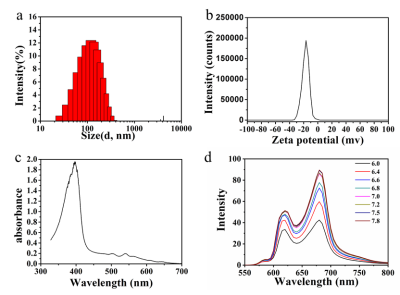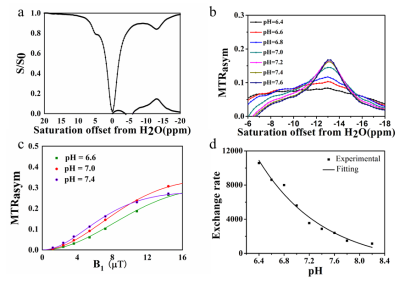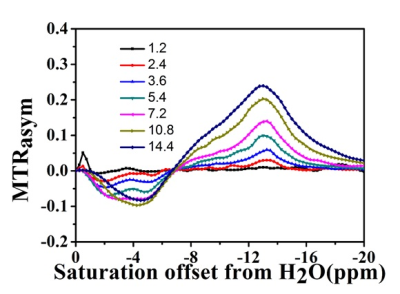2421
Cross-Linked Protoporphyrin IX polymer as Efficient, Tunable CEST MRI NanoPlatform for molecular Imaging
Xiaoxiao Zhang1, Zhigang Wu1, Peng Sun1, Zhiwei Shen1, Liangjie Lin1, Geli Hu1, Haoyu Huang1, and Jiazheng Wang1
1Philips Healthcare, Wuhan, China
1Philips Healthcare, Wuhan, China
Synopsis
CEST MRI is an novel molecular imaging technique in which the contrast is generated by the dynamic exchange between the exchangeable proton and water. Porphyrin and its analogues are a promising class of highly sensitive, diamagnetic CEST agents with highly upfield shifted protons. We synthesized a water-soluble polymeric CEST MRI agent grafted with protoporphyrin IX(PpIX). The PpIX polymeric agent resonated at -13.5 ppm from water and showed excellent CEST MRI properties.
Introduction
CEST imaging represents an attractive alternative strategy because the MR contrast is not only reflecting metabolite level directly, but also provides information on tumor microenvironments such as pH, enzyme 1. The CEST MRI contrast is generated from exchangeable protons on organic molecules when a selective saturation pulse irradiated these protons. However,many existing CEST MRI agents exhibit low sensitivity because of the small chemical shift between the labile protons and water. As a solution, increasing the chemical shift is beneficial to enhance CEST contrast on lower field scanners. Free-base porphyrins and chlorin could act as diamagnetic CEST agents with highly upfield shifted exchangeable protons (between -9 and -13.5 ppm from water) 2. The new type of contrast agent encourages us to extend the scope of application to translate these probes for MRI guidance of PDT using a single free base porphyrin molecule. In terms of biocompatibility, the natural protoporphyrin IX (PpIX) would be a good CEST contrast agent candidate. However, PpIX is severely limited by its low water solubility and a tendency for aggregation. Herein we describe the direct use of natural protoporphyrin IX as the copolymer to yield stable, water-soluble copolymer, in which the protoporphyrin IX served as a dual CEST/ photosensitizer agent.Materials and Methods
PpIX, acrylic acid, azobisisobutyronitrile (AIBN), and N, N-Dimethylformamide (DMF) were commercially available and purchased from Aladdin. PpIX polymer was performed according to previous literature [3]. Hydrodynamic diameter and Zeta potential of PpIX polymer were characterized by dynamic light scattering (Nano ZS 90, Malvern, UK). CEST MRI was performed on 9.4T MRI (Bruker Biospec, Ettlingen, Germany).Results and Discussion
As shown in Figure 1a, this functionalized polymer consisted of PpIX and acrylic acid. A facile approach uses natural PpIX as the cross-linker in the polymer via a radical-induced polymerization. The two vinyl groups in PpIX as the copolymer is key for the polymerization. Dynamic light scattering (DLS) measurement showed that the hydrodynamic diameter of polymer is about 105 nm (Figure 1a), and Zeta potential is about -16.8 mV (Figure 1b). PpIX polymer also showed excellent fluorescence features with long excitation and emission wavelength. Firstly, CEST MRI was performed using different concentrations of PpIX polymer in PBS. As shown in figure 2, At neutral pH, PpIX polymer produced strong CEST contrast with a far-shifted peak at -13.5 ppm from water due to the inner NH. (Figure 2a). The peak at -13.5 ppm is shifted well past labile protons found in well-characterized tumor metabolites which resonate between 1-4 ppm from water, making this signal well suited for specific probe detection. We characterized the CEST contrast of PpIX polymer as a function of pH (Figure 2b) and measured the proton exchange rates using a QUESP experiment [4]. PpIX polymer has a ksw=5.27 ks-1 at pH=7.0, which is strongly dependent on pH (Figure 2c and 2d). At physiological pH values (pH = 6.4 -7.6), the ksw is below the chemical shift difference at 9.4 T (∆ω = 2,500 Hz), placing these in the slow exchange NMR regime and making this agent well suited for CEST imaging. we tested the influence of human serum on PpIX polymer. MR data were acquired on 10% normalized human serum titrated to pH 7.3 with and without 10.6 mM PpIX polymer. As seen in figure 3, at this concentration Human serum albumin does not interfere with the CEST signal of PpIX polymer.Conclusion
In this work, we present a novel CEST contrast agent was using clinically compatible agents (PpIX). This represents a new class of polymeric CEST MRI contrast agents with good water solubility and CEST effect. The polymeric materials could be used as a platform for MRI guidance of photodynamic therapy. More work is ongoing for the in vivo MR imaging using PpIX polymer.Acknowledgements
No acknowledgement found.References
[1] McMahon MT, Gilad AA, Bulte JWM, van Zijl PCM. Chemical Exchange Saturation Transfer Imaging: Advances and Applications. Singapore: Pan Stanford Publishing; 2017. 479 p; [2] Zhang X, Yuan Y, Li S, et al. Free-Base Porphyrins as CEST MRI Contrast Agents with Highly Upfield Shifted Labile Protons. Magnetic Resonance in Medicine, 2019, 82, 577-585. [3] Simin B, Huguette S, Jessica M, et al Synthesis and Characterization of Temperature Sensitive and Chemically Cross-Linked Poly(N‑isopropylacrylamide)/Photosensitizer Hydrogels for Applications in Photodynamic Therapy, Biomacromolecules 2018, 19, 1592−1601. [4] McMahon MT, Gilad AA, Zhou J, Sun PZ, Bulte JW, van Zijl P. Quantifying exchange rates in chemical exchange saturation transfer agents using the saturation time and saturation power dependencies of the magnetization transfer effect on the magnetic resonance imaging signal (QUEST and QUESP): pH calibration for poly-L-lysine and a starburst dendrimer. Magnetic resonance in medicine 2006, 55(4): 836-847.Figures

Figure
1. (a) hydrodynamic diameter
of hemin polymer (105 nm); (b) Zeta potential of hemin polymer (-16.8 mv); (c) UV
spectral; (c) fluorescence spectral.

Figure 2. Characterizing the CEST
porperties of PpIX polymer . (a) Z-spectrum and MTRasym; (b) MTRasym at
defferent pH; (c) QUESP data at pH = 6.6, 7.0, 7.4; (d) exchange rates at defferent
pH.

Figure 3. Characterizing the CEST
properties of PpIX polymer in 10% human serum at different B1(µT).
DOI: https://doi.org/10.58530/2022/2421